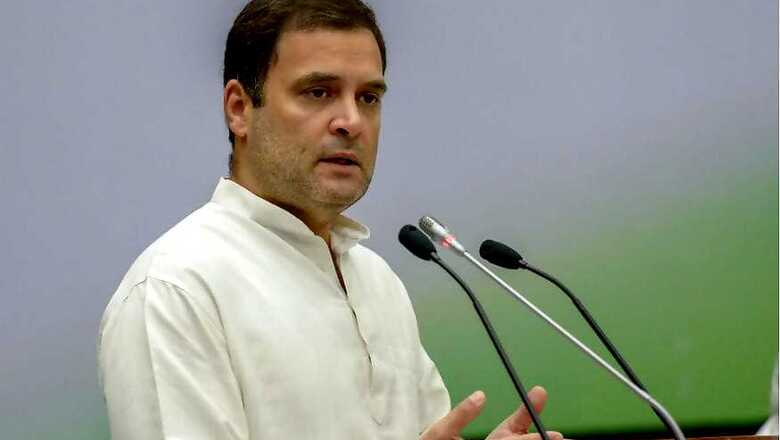
views
The Opposition ideally lost a golden opportunity last Saturday to put the Narendra Modi regime on the mat on all fronts, including the economy.
The ‘hug’ stole the show and reduced the Opposition’s no-confidence motion against the government and the final tally of ‘Ayes’ and ‘Noes’ inconsequential.
Looks like the Congress president isn’t giving up despite the BJP’s paid and voluntary army of trolls riling him day in and day out to an extent that all of that derision is well past an expiry date.
Take any shining star of the current political universe, s/he has had their share of failures, setbacks, and ridicule. Rahul Gandhi’s trajectory, therefore, is no exception.
Uddhav Thackeray faced desertions, lost every election after becoming the Shiv Sena working president — from panchayats to the assembly, but for retaining a cash-rich Brihanmumbai Municipal Corporation in 2012. He tasted some success finally in 2014, only half a success if it were. Mamata Bannerjee began with a string of failures before she conquered the Red bastion in 2011. Late Indira Gandhi had to quell the rebellion within and from the Opposition that comprised stalwarts. Nitish Kumar too; the list goes on.
In short, Rahul Gandhi’s political journey isn’t over. It’s just getting started.
Not on that impromptu hug or his new posturing of hatred-versus-love, Gandhi’s journey from here on hinges on whether he is able to act and how quickly on the “biggest task” he identified for his party in last Sunday’s Congress Working Committee (CWC) meeting.
“Expansion of our party vote base is one of our biggest tasks. In each constituency, we have to find people who have not voted for us and develop a strategy to reach out to them and win back their trust,” Gandhi was quoted as saying at the CWC meet, in a seemingly inconsequential tweet from his party’s official Twitter handle.
It made no news, obviously. For it pales in front of the hug story. But, it is singularly the most important thing to revive his party’s and his own political fortunes.
In the short term though, the Congress has indicated that it would play an enabler in weaving a broad anti-BJP coalition, but it won’t be a cakewalk either. The BJP has built an apparatus that is not easy to defeat in many states.
But Gandhi’s statement had three important points: “find people who have not voted for us”; “develop a strategy”; “win back their trust”.
This calls for an instrument, a narrative or policy and a fresh programme. Each of these components is a work-in-progress for years to come, but for the Congress to reinvent itself, it must begin somewhere. The starting point may be the apparatus that is empty and craves for an urgent attention.
In the four years since the Congress was swept out of power in the Centre and in state after state successively, and had begun looking irrelevant, it is the first time that the party president has drawn attention to a task that should have long been a priority. It is what all regional leaders do to win people’s confidence and elections.
You win elections not merely on an ideological plank or by attacking your rival for his perceived failures — it’s important, yes. But in a representative democracy, you win elections at every booth by convincing people of every faith, every caste, gender, and voting age to vote for your candidate. You win elections by polling votes at every booth more than your rivals do.
Ultimately, it boils down to this: Electoral arithmetic in polls to all tiers — Lok Sabha, Vidhan Sabha and local bodies — needs a candidate to win at least 250 votes at every polling booth to be in the reckoning.
Congress is losing every election at this first and last frontier, because it has neglected it for a long time.
Each polling booth has an average 800-1,200 voters — or an average of 1,000. A local body election typically has 50-60 polling booths. A legislative constituency typically has 325 booths. A Lok Sabha constituency has 1,800-2,000 booths. India had a staggering 930,000 polling booths for 814 million registered voters in the 2014 general election; this is bound to go up when people vote again in 2019.
Even if you get one worker per booth, you still need close to a million individuals manning the party at the frontier.
That’s not easy. To have those many workers across the country with adequate representative character and calibre requires one hell of an effort.
Voting percentage hovers between 60 and 80, which means 600 to 800 votes in every polling booth of 1,000 voters. If a candidate is sure to get 250 votes of the votes polled, s/he’s in the reckoning but to win the booth, and thus the election, a candidate needs to pull the undecided or floating votes in his or her favour.
The Congress’ problem has been a shrinking social base. In many states, or regions, it does not even exist at the booth-level. For instance, the party has almost given up on lower OBCs, a rubric of 3,000-plus castes that are scattered thinly all over the country. They don’t demand tickets for elections, but covet representation.
Over 30 years that the Congress alienated them, the BJP through its own apparatus and that of the RSS, has meticulously mobilised lower OBCs, who along with its core base, wins the party a booth.
It was evident in the UP elections last year. The BJP has done so by accommodating these communities in its organisational and electoral character. Their numbers and character changes from state to state though.
Whether it’s a national or a local body election, winning 250 plus voters in every polling booth with a diverse socio-religious composition as a core base depends on the party’s local unit and its representational character.
For, who gets you votes at a polling booth? Certainly not a national leader! A grassroots party worker/leader gets you those votes. Why will he fetch you votes unless he has a stake in those elections? A party therefore needs to create spaces and political incentives for its committed workers to do what is otherwise a thankless job if he has no stakes in winning the game. He covets attention of his leadership, space within the organisation, and a pat for doing a good job, other than a political incentive and a say in the party’s processes.
If the Congress president wants to revive his party and win elections, it warrants the revival of organisational apparatus. After all, where does a party worker come from? He comes from the same bastis, villages, wards and by-lanes from where the voters come. A local party worker is as important as the party ideology to reach out to the masses scattered over thousands of villages, cities and hamlets. And hundreds of castes, sub castes, religious, ethnic, linguistic backgrounds. Any party’s programmatic and representational character can be taken to the masses only through the workers from different caste, religious and ethnic backgrounds.
For instance: Kunbi, Mali and Bagwan are three caste groups belonging to agricultural background but each will need to be represented in the party by a local worker to win over or reach out to the respective caste groups. Our social realities are that a Kunbi leader cannot win over or reach out to a Bagwan voter or vice versa.
India has some 25 lakh constitutional/statutory posts, nearly 20 lakh of them in panchayati raj institutions: in gram panchayats, panchayat samitis (janpad panchayats and blocks), zilla parishads, municipal councils, municipal corporations, legislative assemblies and Parliament.
You need as many individuals to contest those elections. This apart, the Congress organisation requires, or can easily accommodate, about two lakh individuals in different positions in some 1,400 party units (central, states, districts, tehsils, blocks and booths) and its allied organisations. It’s here that the party would accommodate political animals from a diverse socio-religious, ethnic, caste-class background.
A once-massive Congress organisational apparatus is largely empty. It does not have more than half of its units functional and in many states it does not have representation in the statutory positions. The Congress always gave functional autonomy to its local unit, had regional outlook, always a national perspective on any issue, and a responsive national leadership — all of it lies forgotten.
For long, the Congress’ committed worker has been sidelined and isolated by a band of insecure leaders who can neither win their own seat, nor get others elected. Some such leaders are still alive in the new CWC and a task Gandhi has is to send them packing, if not now, then in the future, to bring up a new worker.
Frankly, social media presence or tweets could win you good headlines, not elections. Also your social media warriors and spokespersons are only that — media warriors. Winning over the masses and elections is a different cup of tea.
The worker brings you votes — going door to door encouraging his fraternity to vote for his party so that they get represented. The Congress was a master in this strategy once — it would accommodate thousands of small, unknown caste groups in their organisational apparatus when they failed to give them tickets in elections.
In fact, the Congress has forgotten the art of contesting local body elections, otherwise why is it that even in the Gandhi pocket-borough of Amethi and Raibareily, there aren’t many Congressmen in local bodies.
The late Vilasrao Deshmukh, former chief minister of Maharashtra, who rose from the post of sarpanch of his village in Latur, had once told me in an interview during a local body election that it was an election of the party worker, who works round the year, round the clock, and hence is important. In state after state, Congress would give equal, if not more, importance to local body polls, for it was there that a worker got his incentive.
When Gandhi says his party needs a strategy to win back votes, he would do well to consult thousands of local satraps the party’s entrenched middlemen have kicked aside — local leaders who connect with masses and win elections, local or national, without money or muscle power or patronage in Delhi Durbar.
(The author is a Nagpur-based journalist. The views expressed are personal.)



















Comments
0 comment